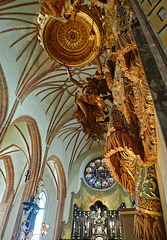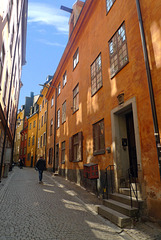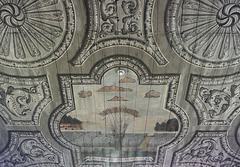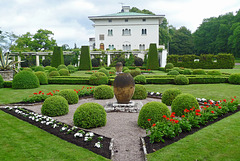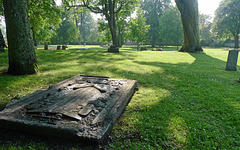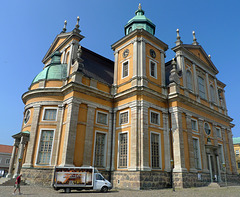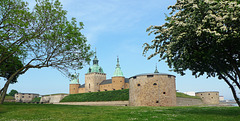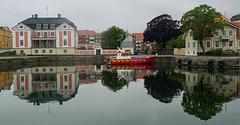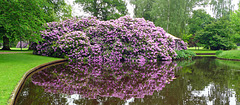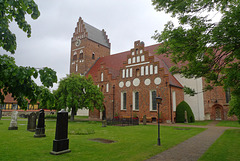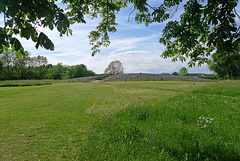
Zweden - Sverige - Sweden
Sweden - Sigtuna, Mariakyrkan
| |
|
|
|
The construction of the ‘Mariakyrkan’ (St. Mary’s Church) started in the year of 1230 and was inaugurated in 1247. It is the oldest stone building in the area around Lake Mälaren. The church was built even before Stockholm was founded. The beautiful brick exterior shows a style between Romanesque and Gothic.
The church originally belonged to a Dominican monastery, but was demolished after the Reformation in 1530 and the Mariakyrkan became the local parish church. The church is the only medieval church in Sigtuna to have survived the Reformation.
The interior houses a number of fine medieval artifacts and wall paintings. The altarpiece has sculpted figures of the 14th century (PiP 1) and beneath the beautiful stained-glass window is a magnificent altarpiece, which probably was made in Sigtuna (PiP 2).
Sweden - Märsta, Steninge Slott
| |
|
|
|
The history of Steninge began at the end of the 13th century when the first known settlement was established in this area. In 1667, Carl Gyllenstierna inherited the Steninge estate. His relationship with the queen allowed him to develop the estate and the beautiful areas around Lake Mälaren. In 1680 the well known architect Nicodemus Tessin the Younger was asked to design a palace. He was inspired by the French and Italian baroque style.. In 1705 Steninge Slott (Steninge Palace or Steninge Manor) was completed, overlooking Swedish largest lake.
Several buildings are dotted around the palace, in particular a huge stone barn dating from the end of the 19th century (PiP2), now housing several shops, an art gallery and a restaurant. Nowadays Steninge Slott is privately owned by a company and used for cultural events.
Steninge Slott, is considered being “Sweden’s most beautiful and perfect baroque building”. I have to say that from a distances it looks quite good, but coming closer it was obvious that the manor could use some serious maintenance (PiP 1).
Sweden - Drottningholms slott
| |
|
|
|
Drottningholm Palace is located just outside the city borders of Stockholm on an island (Lovön ) in Lake Mälaren. The palace is the official home of the Swedish royal family since 1981.
Drottningholm (= Queen’s island) is dating back to the late 16th century, when King Johan III built a palace for his wife. In 1661 the palace was destroyed by a fire. One year later the building on a new palace - as it still is nowadays - began.
Drottningholms slott is surrounded by a French formal garden (PiP 1) and a more natural English style park (PiP 2) with ponds and lawns.
In 1991 Drottningholm Palace was added to UNESCO's World Heritage List.
Sweden - Stockholm, Storkyrkan
| |
|
|
|
Stockholm’s Storkyrkan (Great Church) is also known as Sankt Nikolai kyrka or Domkyrka (Church of St. Nicholas or Cathedral). The church is located next to the Royal Palace and is the oldest church of Gamla Stan.
The medieval cathedral is dating back to the year of 1279 and was originally built by Birger Jarl, the founder of Stockholm. Storkyrkan is an important example of Swedish Brick Gothic and the oldest building still in use in Stockholm. .
Since 1527 the cathedral has been a Lutheran Protestant church. The church is often used for major (royal) ceremonies such as coronations, weddings, crownings and funerals.
The Gothic interior (PiP 2) of the church - dating back to the 15th century - offers a lot of unique and important art objects, among them the impressive Royal Pews (picture + PiP 1).
Sweden - Stockholm, Kungliga slottet
| |
|
|
|
The Royal Palace (Kungliga Slottet) is one of Europe’s largest palaces. The interior of this impressive building consists of 1.430 rooms of which 660 have windows. It is still the official residence of the Swedish King and Queen and also the work place and is used for official receptions.
The palace is built in Italian baroque style in the 18th century on the site of the former ‘Tre Kronor’ castle, which burned down in 1697. The royal family was not able to move back in until 1754, nearly sixty years after the fire.
The royal palace is open for public and offers also several museums.
See for more info: www.kungahuset.se/royalcourt/visittheroyalpalaces/theroyalpalace/thepalace.4.396160511584257f2180003755.html
Main picture: royal palace of Stockholm
PiP 1: interior of the royal chapel
PiP 2: inner court of the palace
PiP 3: royal guards in front of the palace
Sweden - Stockholm, Gamla Stan
| |
|
|
|
‘Gamla Stan’ (Old Town) is Stockholm’s medieval city centre, where Stockholm was founded in the year of 1252 by Birger Jarl. It is the historical heart of Stockholm and consists of the three islands Stadsholmen’, Riddarholmen and Helgeandsholmen. Helgeandsholmen
When people mention ‘Gamla Stan’, they usually think of Stadsholmen, the largest of the three. Until the 19th century it was simply called ‘Staden’ (City). Later it became known as the ‘Staden mellan broarna’ (City between the bridges). Since 1980 it has been called Gamla Stan.
Although ‘Gam la Stan’ dates from the 13th century, most of its buildings are from the 17- and 1800s. It is a labyrinth of narrow winding cobblestone streets, alleyways, beautifully pastel coloured town houses and squares with a German influenced architecture.
Some of the main (shopping) streets can be very overcrowded by tourists, but once you enter the side streets it feels like you are walking back in time.
Pictures:
Main picture - Prästgatan (Priest’s Street) ran just inside the former defense wall; it is considered being one of the most beautiful streets of ‘Gamla Stan’.
PiP 1: Brända Tomten, one of the most scenic squares with a triangular shape surrounded by picturesque houses and a chestnut tree in the middle.
PiP 2: Kindstugatan, one of the quiet side streets
PiP 3: Stortorget, the main square of Gamla Stan
Sweden - Västervik, S:ta Gertruds Kyrka
| |
|
|
|
S:ta Gertruds Kyrka (St. Gertrud’s Church) was built in the 1450’s after King Eric of Pomerania had ordered to move the town of Västervik from Gamleby to its current location. The city was destroyed in a battle in 1517 and inhabitants moved back to the old city. After King Gustav Vasa ordered them to move back, St. Gertrud’s Church was restored as a Lutheran church. It was once again destroyed in 1612 during the battle against Denmark. The church was renovated and enlarged until 1739.
Religious services were held in the church for nearly 500 years, until the last morning service was held there one Sunday in 1905. In the same year Västervik became a new church and St. Gertrud’s Church was used for grain storage during the First World War.
The church was re-established as a place of worship and in June 1933 St. Gertrud’s Church was re-inaugurated.
S:ta Gertruds Kyrka has many valuable items of furniture include like a pulpit and organ from 1743, which is considered to be one of Sweden’s most valuable, an altarpiece from the late 1600’s.
I was really impressed by some beautifully painted ceilings (main picture).
Sweden - Västervik
| |
|
|
|
Old water pump on a square, next to the St:a Gertruds Kyrka (St:a Gertruds church).
This old water pump was one of several public water pumps in Västervik that was used before the town council decided to build a modern water- and pluming system in order to improve health and hygiene. The new and modern system became in use in the year of 1906.
Most probably the water pump has been placed in the area before 1906, because there have been different public buildings nearby, like a school and a home for poor and elderly people, both built in the 19th century.
.
Sweden - Småland, Strömsrum
| |
|
|
|
Strömsrum is one of these ‘in the middle of nowhere’ hamlets in Sweden’s countryside. It has just a few Falu red painted (farm)houses, and a beautiful mansion. Strömsrum is situated in a beautiful park landscape with old oak trees, which is bisected by the slow flowing river Alsterån.
Strömsrum slott - one of the oldest wooden mansions in the country - is dating back to the year of 1312 (see PiP).
Sweden - Öland, Solliden slott
| |
|
|
|
Solliden slott (Solliden palace) is a fairly modest summer palace - better call it a villa - of the Swedish royal family. It was commissioned by Queen Victoria and built between 1903 and 1906. The Italian-style country house was designed by Torben Grut. The current Swedish king Carl Gustaf XVI inherited the palace in 1950 and is still used as a summer residence by the Swedish royal family.
The gardens of Solliden Palace are open to the public from May to September. Solliden Palace is located on the island of Öland, in southern Sweden, nearby Kalmar.
Sweden - Kalmar, Gamla Kyrkogården
| |
|
|
|
Gamla Kyrkogården (Old Cemetery), located in the former medieval city of Kalmar, is dating back to the first half of the 13th century. It is the oldest Christian burial ground in Kalmar. At the square of the Old Town stood the Bykyrkan (Village Church) and in connection with it the cemetery was laid out.
The Village Church was blown up during the 1670s, when the whole city of Kalmar was moved to it´s present place on Kvarnholmen. Gamla Kyrkogården kept in use till the 1860’s and remained at its original place, till the South Cemetery, close to Kalmar Castle, was ready
Several old gravestones can still be seen in the cemetery, many with unusual motifs and forms. The place where the old church stood is marked with a memorial plaque as well as stones that show where the foundation stood. There are tombstones from the 17th and 18th centuries and standing gravestones from the 19th century. Several of these stones were locally made, using limestone from Öland. Memorial crosses of cast iron became common in the middle of the 19th century
One of the most remarkable gravestones (see first PiP) shows a knight (Christopher Andersson Grip) and his wife; both seem to be beheaded. According to a plaque they died in 1588 and 1599.
Sweden - Kalmar domkyrka
| |
|
|
|
‘Kalmar domkyrka’ (Kalmar Cathedral) is located in the heart of the new city and dominates the central square ‘Stortorget’. According to the renaissance ideals of the mid 17th century the church and the town hall were places across from each other at the square. The new fortified city - built on the island ‘Kvarnholmen’ - was completed in the year of 1658. Two years later the construction of the cathedral started, but due to several interruptions it was finished in 1703. It has been built in a Scandinavian variant of baroque style with richly decorated facades and pilasters of limestone.
The interior of the church - remarkable bright - is laid out according to Evangelical Lutheran tenets with a focus on the main altar. This baroque altar was designed in 1704 and depicts the Trinity: Father, Son and Holy Spirit. The interior shows beautiful furnishings and fixtures with graves, epitaphs and a sculpted pulpit from the mid 17th century. In the center of the ‘domkyrka’ hangs a brass chandelier with 36 arms.
Sweden - Kalmar, Kalmar Slott
| |
|
|
|
The first defensive constructions on the place of the present Kalmar Castle were built in the 12 and 13th century. Kalmar Castle was an important fortification and known as the key to the kingdom because of its strategic location. The Swedish-Danish border was located only a short distance to the south, because the provinces of Scania and Blekinge were Danish territory for a long time.
Kalmar Castle became its current design during the 16th century by several Vasa kings. They turned the medieval fortress into a renaissance castle.
The castle suffered heavy damage during the Kalmar War of 1611-13 and was badly damaged by a fire in 1642. Repairs were begun but from the end of the seventeenth century the castle was allowed to fall into disrepair.
In 1856 restorations were initiated restoration work at Kalmar Castle and by 1891 the castle had gained the silhouette it bears today. Early 20th century the earthworks, the moat, the bridge and the drawbridge were restored. Work continued until 1941, when the castle was once more surrounded by water. Today Kalmar Slott is one of Sweden's best preserved renaissance castles.
Sweden - Nybro, Pukeberg Glasbruk
| |
|
|
|
Pukeberg Glasbruk (Pukeberg Glass factory) is (or better was) one of Sweden’s oldest and most well-preserved glassworks. Glass has been produced here since 1871; the former factory is located in a wonderful green environment nearby the town of Nybro. It is part of the so called Glasriket (the Kingdom of Crystal), a region in the Swedish province of Småland, where hand-blown glass has been made since 1742.
Pukeberg is no longer a running factory and during my visit there were just a couple of ‘glass activities’ in the former factory buildings like a glass blower, a large glass shop and a smaller museum. Pukeberg is becoming more and more a centre for new (glass) activities.
Sweden - Karlskrona, Kungsbron
| |
|
|
|
In the past - when the most frequently way to visit Karlskrona was by water - Kungsbron (Kingsbridge) was the front door to the city. The residents of Karlskrona once gathered at Kungsbron to welcome kings and other guests.
The pink and white building is the residence of the county governor. The view from Kungsbron over the nearby islands is enchanting.
Sweden - Ronneby, Brunnspark
| |
|
|
|
At the end of the 19th century Ronneby Brunn was a famous spa. People went here for the nourishing mineral water as well as the beautiful surroundings. The beautiful Brunnspark is a spa park with a history that goes back to 1705, when a Danish landscape designed the 100 hectares large park with wooden buildings.
n the 1980s a famous Swedish landscape architect planned and designed the restoration of the park by adding new elements. The ‘spa buildings’ are also renovated and host modern companies.
In 2005 the park was named Sweden’s most beautiful park; one year later Brunnspark came fourth in the “Europe’s most beautiful park” competition.
We were lucky (early June) seeing all the flowering rhododendrons.
Sweden - Åhus, Sankta Maria kyrka
| |
|
|
|
Sankta Maria kyrka (St. Mary"s Church) was built in the 12th century - and enlarged a century later - in a style like the German brick Gothic; it is one of the oldest buildings of Åhus. The church was enlarged a century later and has been restored and rebuilt several times. The bell tower was added in late Middle Ages.
The interior with the blue coloured pews is quite large and offers several treasures. The retable has beautiful carvings and offers after a restoration its original colours. The Renaissance style pulpit dates from the 1600s and is decorated with images of St. Paul and the four evangelists.
Sweden - Kivik, Kungagraven
| |
|
|
|
Kungagraven (King's Grave) is a grand Nordic Bronze Age double burial, about 3.500 years old. Thee mound has a diameter of 75 metres. The site has been used as a quarry and its stones carried off for other uses. The cists are adorned with petroglyphs carved into the stones.
In 1748 two farmers discovered the 3.25 meter tomb constructed with ten slabs of stone. Several years passed before it was discovered that the slabs of stone in the tomb were adorned with petroglyphs. Between 1931–1933 a thorough excavation was undertaken and the remains of a Stone Age settlement were found under the massive cairn.
The mound has been named Kungagraven due to its size, long before it was known to contain two burials. The restoration of the site was based on etchings from the 18th century and conjecture. A new chamber was constructed out of concrete and a tunnel extended into the cists.
It is possible for visitors to enter the tomb and to see the engraved stones.
Jump to top
RSS feed- Latest items - Subscribe to the latest items added to this album
- ipernity © 2007-2024
- Help & Contact
|
Club news
|
About ipernity
|
History |
ipernity Club & Prices |
Guide of good conduct
Donate | Group guidelines | Privacy policy | Terms of use | Statutes | In memoria -
Facebook
Twitter




